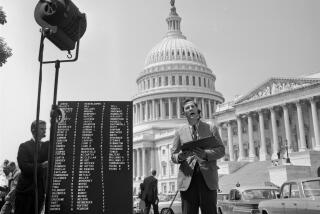THE GLORIOUS FOURTH An American Holiday, an American History<i> by Diana Karter Appelbaum(Facts on File: $19.95; 180 pp.) </i>
- Share via
“Every generation celebrates holidays in a manner consistent with its desires,” writes Diana Karter Appelbaum in her introduction to this history of the celebration of Independence Day in America. What follows is a discussion of the events of the first Independence Day (we would have celebrated independence on July 2 had our founding fathers been less long-winded) and what significance succeeding generations chose to attach to it.
The first few anniversaries of the new country, of course, resembled the celebration of revolutions the world over: a dogmatic insistence by the new leaders that their actions had been correct. In later years, celebrations became increasingly partisan, although some towns devised stratagems to keep the revelry noncombative. “From the 1820s onward, most towns managed to hold patriotic exercises on the Fourth of July that excluded no party, confining politics to toasting rival candidates and party heroes. . . . Since men who have drunk 20, 40, or more toasts will fail to act with circumspection when they hear their political heroes insulted by partisans of a rival party, many towns that managed to hold unified exercises in the sober morning hours found it expedient to allow party loyalty to determine the guest list for the afternoon’s holiday dinners.”
The Fourth of July was always a popular time for discussion of the political issues of the day. In the 1830s and ‘40s, traditional celebrations were invaded by sober celebrants preaching temperance. At about the same period, black communities expressed their ambivalence about celebrating American independence by observing rival feast days, among them August 1, the day in 1834 when slavery was abolished in the British Empire. The post-Civil War period, by contrast, saw a self-conscious emphasis on national unity.
Appelbaum’s story takes the reader up into the 20th century, as the holiday becomes progressively de-politicized and the main issue becomes the danger of private fireworks. The illustrations alone provide a fascinating social history, from paintings of the first reading of the Declaration of Independence to photographs of back-yard barbecues.
More to Read
The biggest entertainment stories
Get our big stories about Hollywood, film, television, music, arts, culture and more right in your inbox as soon as they publish.
You may occasionally receive promotional content from the Los Angeles Times.










